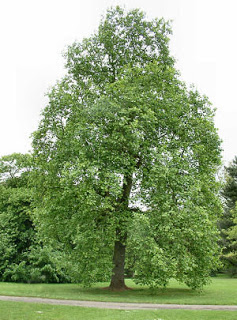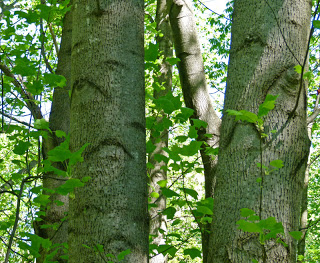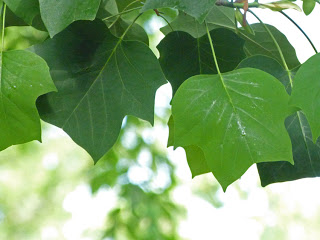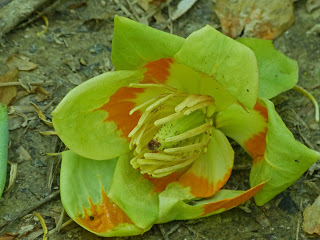The tuliptree is one of the tallest eastern American hardwoods, and one of the tallest trees found in the nature preserve. It can often be identified from a distance because of its very straight, tapering, light-colored and evenly furrowed trunk which, on mature trees, is usually free of branches for a considerable distance from the ground. Common names include tuliptree, tulip poplar, yellow poplar, whitewood. Although it is commonly referred to as a tulip poplar, Liriodendron tulipifera is not closely related to the true poplars, nor is it related to the ornamental flowers we call tulips. It is a member of the Magnoliaceae family, along the many flowering trees of the genus Magnolia. The tulip tree is the state tree of Indiana, Kentucky and Tennessee.
Up close, it is even easier to recognize, with its distinctive leaf shape which would be hard to mistake for that of any other tree. The large, hairless, glossy, alternate, simple leaves of the tuliptree are four-pointed, with an indented summit that makes it look as if the tip has been cut off.
In mid- to late May or early June, after its leaves are developed, the tuliptree blooms, with prominent, colorful tulip-like flowers, from which the tree gets its fanciful name. The flowers have 6 yellowish-green and orange petals and three large sepals at their base. They produce a good amount of nectar and are pollinated by bees. The fruit, in the form of a narrow winged seed (samara) 1-2 inches long, is clustered in 2-3 inch cone-shaped structures which persist on the branches through the summer and into the fall. They are dispersed by wind.

The tuliptree is a particularly valuable tree for lumber because of its tall, straight trunk and wood that is soft, lightweight, straight-grained, resistant to splitting, and easily worked. Native Americans and early pioneers frequently hollowed out a single log to make a long dugout canoe, giving it the common name “canoe tree” in some regions. Sold commercially as “yellow poplar,” it is used for furniture, musical instruments, interior finishes, shingles, boats, plywood, fuel, and various small objects. Tulip poplars are weather resistant, and termite resistant. Pioneers preferred these logs to other logs for homes. In fact they were exported to Europe because they were recognized as a superior log.
The root of the tuliptree can be used as a lemon-like flavoring agent in spruce beer. The bark contains ‘tulipiferine,’ which is said to have powerful effects on the heart and nervous system.
Tea made from the bark has historically been used to make an aromatic stimulant tonic, which is said to be beneficial in the treatment of rheumatism, chronic gastric and intestinal diseases, dysentery, coughs, and hysteria. Externally, the tea is used as a wash and a poultice on wounds and boils. The raw green bark can be chewed for its purported aphrodisiac effects, and the root bark and seeds have been used to expel worms from the body.






